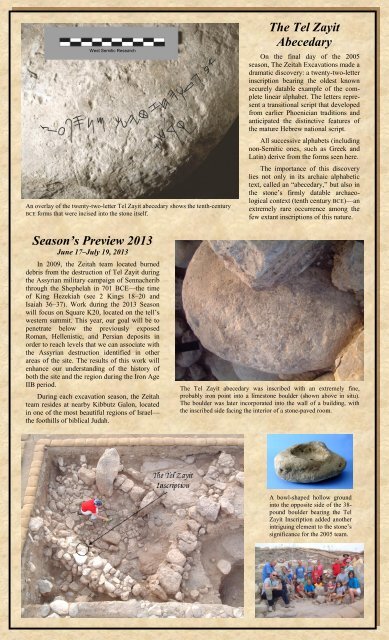2013 Brochure - The Zeitah Excavations
2013 Brochure - The Zeitah Excavations
2013 Brochure - The Zeitah Excavations
You also want an ePaper? Increase the reach of your titles
YUMPU automatically turns print PDFs into web optimized ePapers that Google loves.
West Semitic Research<br />
An overlay of the twenty-two-letter Tel Zayit abecedary shows the tenth-century<br />
BCE forms that were incised into the stone itself.<br />
Season’s Preview <strong>2013</strong><br />
June 17–July 19, <strong>2013</strong><br />
In 2009, the <strong>Zeitah</strong> team located burned<br />
debris from the destruction of Tel Zayit during<br />
the Assyrian military campaign of Sennacherib<br />
through the Shephelah in 701 BCE—the time<br />
of King Hezekiah (see 2 Kings 18–20 and<br />
Isaiah 36–37). Work during the <strong>2013</strong> Season<br />
will focus on Square K20, located on the tell’s<br />
western summit. This year, our goal will be to<br />
penetrate below the previously exposed<br />
Roman, Hellenistic, and Persian deposits in<br />
order to reach levels that we can associate with<br />
the Assyrian destruction identified in other<br />
areas of the site. <strong>The</strong> results of this work will<br />
enhance our understanding of the history of<br />
both the site and the region during the Iron Age<br />
IIB period.<br />
During each excavation season, the <strong>Zeitah</strong><br />
team resides at nearby Kibbutz Galon, located<br />
in one of the most beautiful regions of Israel—<br />
the foothills of biblical Judah.<br />
<strong>The</strong> Tel Zayit<br />
Abecedary<br />
On the final day of the 2005<br />
season, <strong>The</strong> <strong>Zeitah</strong> <strong>Excavations</strong> made a<br />
dramatic discovery: a twenty-two-letter<br />
inscription bearing the oldest known<br />
securely datable example of the complete<br />
linear alphabet. <strong>The</strong> letters represent<br />
a transitional script that developed<br />
from earlier Phoenician traditions and<br />
anticipated the distinctive features of<br />
the mature Hebrew national script.<br />
All successive alphabets (including<br />
non-Semitic ones, such as Greek and<br />
Latin) derive from the forms seen here.<br />
<strong>The</strong> importance of this discovery<br />
lies not only in its archaic alphabetic<br />
text, called an “abecedary,” but also in<br />
the stone’s firmly datable archaeological<br />
context (tenth century BCE)—an<br />
extremely rare occurrence among the<br />
few extant inscriptions of this nature.<br />
<strong>The</strong> Tel Zayit abecedary was inscribed with an extremely fine,<br />
probably iron point into a limestone boulder (shown above in situ).<br />
<strong>The</strong> boulder was later incorporated into the wall of a building, with<br />
the inscribed side facing the interior of a stone-paved room.<br />
A bowl-shaped hollow ground<br />
into the opposite side of the 38pound<br />
boulder bearing the Tel<br />
Zayit Inscription added another<br />
intriguing element to the stone’s<br />
significance for the 2005 team.


